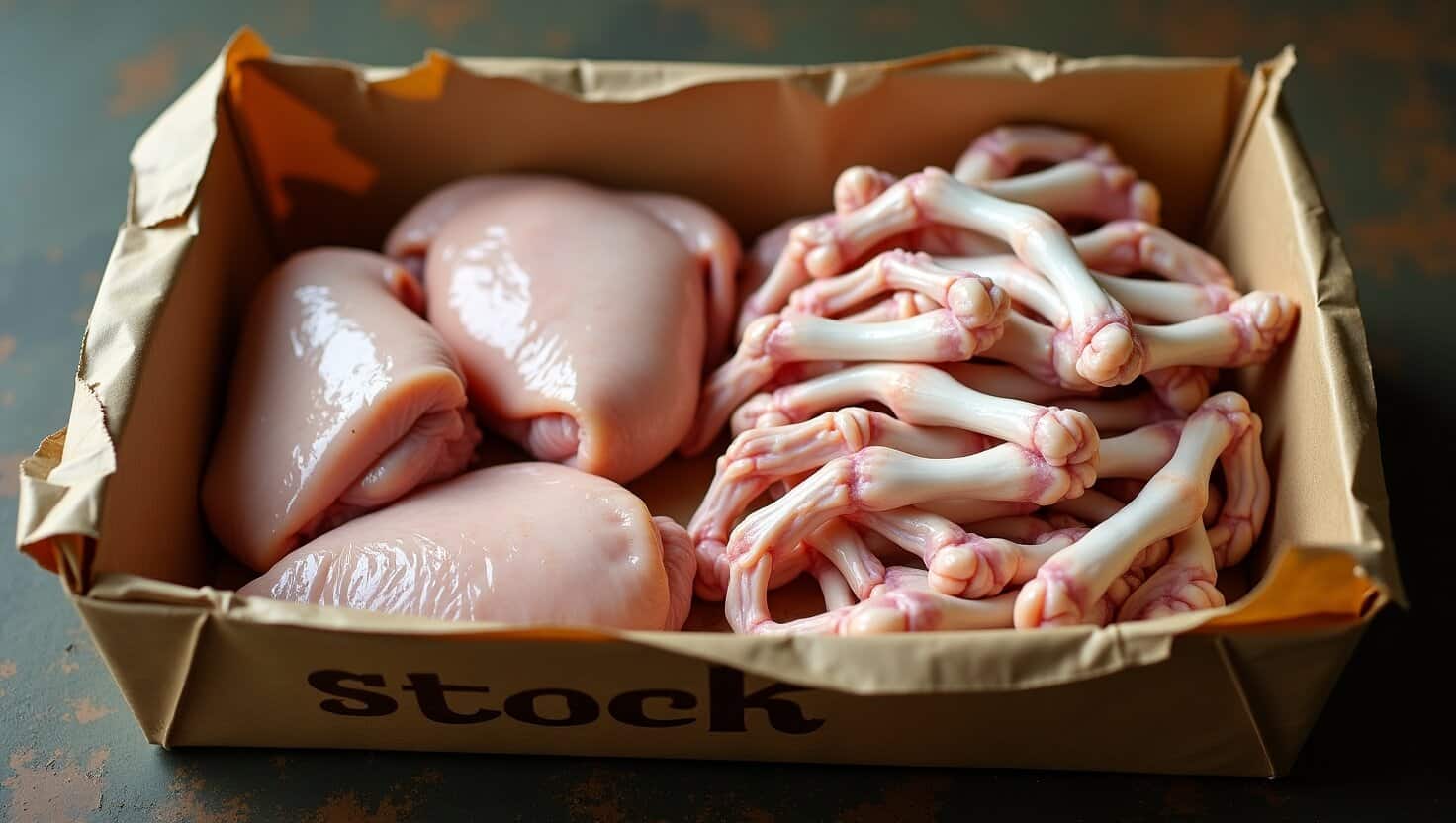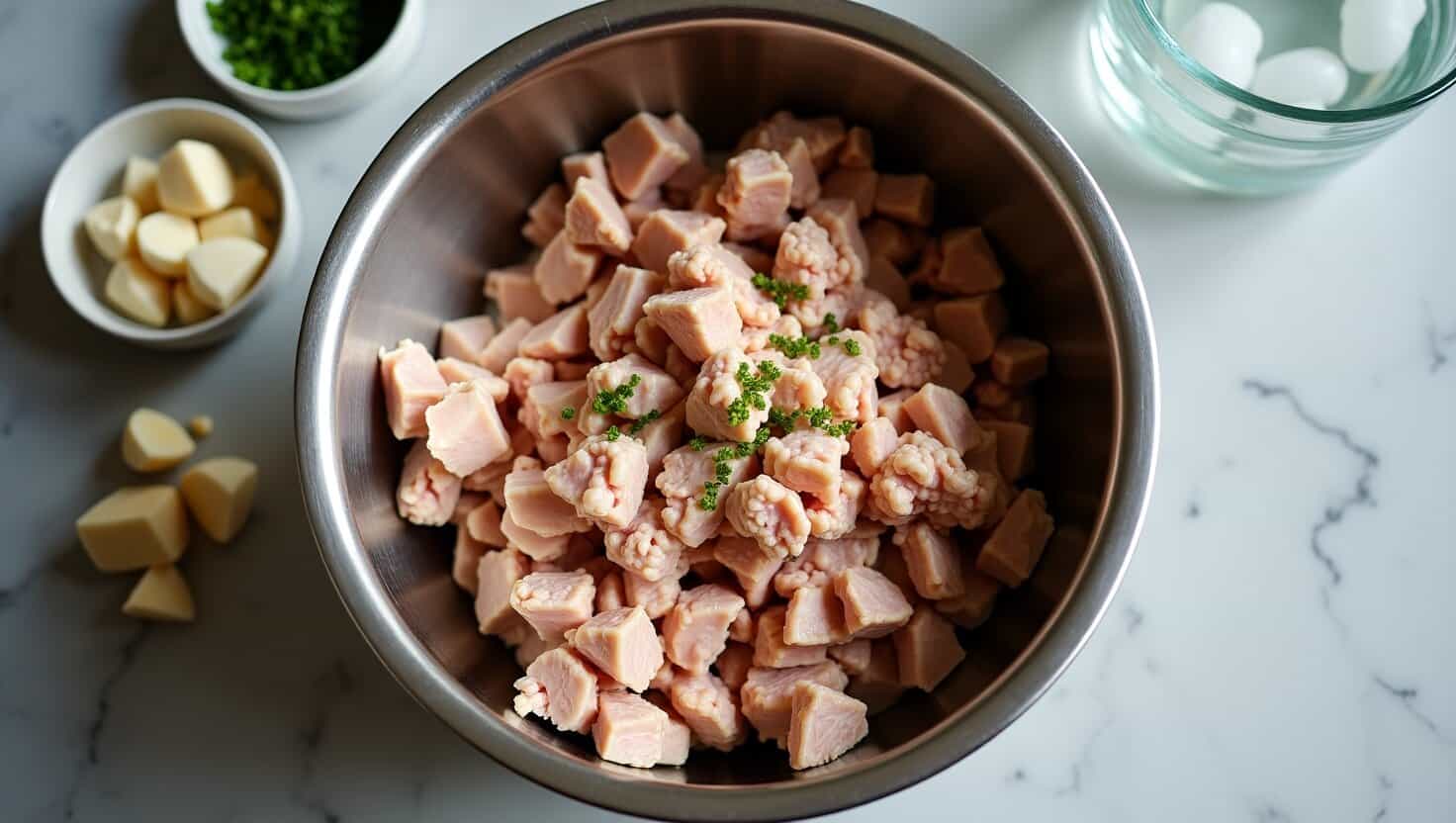First thing, juicy chicken sausage starts with both dark and white meat, skin on, a bit of fat left in. Everything cold, that’s key. Cut up your chicken, toss it with salt, pepper, maybe garlic or fennel, then chill it again. Grind it, add icy broth or water, mix by hand, just until sticky. Don’t rush, but don’t let it warm up either. Stuff into casings, poach gently (160°F, not boiling), then rest. That’s where the juice stays put. Want more tricks for perfect sausage? Keep reading, there’s always another detail that makes all the difference.
Key Takeaway
- Mixing dark and white meat (plus skin or fat) is the secret to juicy, flavorful chicken sausage.
- Keep all ingredients and equipment cold, and add cold liquid for moisture retention.
- Cook gently to 165°F and rest sausages before serving to lock in juices.
Choosing Ingredients for Juicy Chicken Sausage

Selecting the Right Chicken Cuts
The best chicken sausage starts with a mix, dark and white meat. Thighs being fat and deep, breasts keep it lean and clean. Some stick to just thighs, which makes it richer, but a 70/30 thigh-to-breast split usually lands you right in the juicy zone. Always keep the skin. Skip it, and you’ll be chewing on dry sausage for ages.If you spot skin-on, bone-in thighs on special, grab them. Debone at home, use the skin in your mix, and save the bones for stock.[2]
Combining Dark and White Meat for Moisture
All breasts? You’ll regret it. Dries out fast, like chewing on a shoe sole. Thighs (and skin) bring the fat that keeps sausage juicy. If you want even more moisture, add a bit of pork fatback or bacon. Some try organ meat for extra flavour, but that’s not for everyone.
Importance of Skin or Fat Inclusion
Skin’s fat is gold for sausage texture. If you’re not keen, at least keep a 20% fat ratio: use chicken skin, or swap in a bit of cold butter or olive oil. Too little fat, and you’re left with something that tastes like a dry turkey burger.
Essential Seasonings and Flavor Enhancers
 Plain chicken sausage is a missed chance. The right spices make all the difference.
Plain chicken sausage is a missed chance. The right spices make all the difference.
Common Herbs and Spices
- Sage: Standard for breakfast sausage
- Thyme, parsley, rosemary: Freshness
- Nutmeg and black pepper: Warmth, complexity
- Garlic and onion powder: Reliable base
- Paprika or cayenne: A bit of heat
Sweeteners for Moisture
A tablespoon of maple syrup or brown sugar keeps things moist and adds a hint of sweet. Not everyone’s into it, swap for honey or skip for a savoury sausage.
Optional Flavor Variations
- Fresh chopped herbs (parsley, coriander, chives)
- Diced green onion or fennel seed for Italian style
- Lemon zest, preserved lemon, or a splash of white wine for brightness
- Chopped bacon, cheese, or sun-dried tomatoes for the bold
Mix and match. Don’t hold back.
Moisture and Binding Agents
Some sausage makers swear by powdered buttermilk or fermento. They help hold water during cooking, add tang, and protect against dryness.
- Powdered buttermilk/fermento: 2 tablespoons per 500g meat
- Cold chicken stock or water: ¼ cup per 500g for extra juiciness
- Breadcrumbs or milk powder: Optional, but helps soak up moisture
Preparing the Sausage Mixture
Mixing’s simple, but don’t rush it.
Grinding Chicken Meat
If you’ve got a mincer, use the coarse plate for a rustic bite. Food processor works if you’re careful, don’t blitz it too much. Keep everything cold, including the bowl and blades, so the fat stays put.
Mixing Ingredients Evenly
Dump all your seasonings and liquids into the ground chicken, mix by hand. Gloves help if you’re squeamish. It should be sticky, a bit wet. Over-mix and it goes tough, under-mix and you’ll get dry spice pockets.
Ensuring Proper Distribution
Test it, fry a little patty, taste, tweak salt or spice. Saves disappointment later.
Forming Sausages
Creating Sausage LinksIf you’ve got a sausage stuffer and natural casings, fill them up. Don’t overstuff, casings burst. Too loose, you get air pockets.Shaping Patties
No gear? No worries. Shape into 1.5cm thick patties. Keep them even so they cook right.Skinless Sausage Preparation
For skinless, form into logs, wrap tight in foil, poach in simmering water for 20 minutes. Brown in a pan to finish.
Cooking Techniques for Juicy Sausages
Pan-Frying
Heat a non-stick pan with a bit of oil, medium heat. Cook patties or links 2–3 minutes per side, or until they hit 74°C inside. Don’t rush, steady heat keeps them juicy.[1]Poaching for Skinless Sausages
Simmer foil-wrapped logs (or naked sausages) in water. Once cooked, brown in a pan or on the barbie for colour and flavour.Grilling and Baking
Grill over medium, turn every few minutes, or bake at 200°C for about 20 minutes. Always check internal temp: 74°C is the mark.
Tips for Avoiding Overcooking
- Use a meat thermometer, guessing dries them out
- Pull sausages off heat at 74°C
- Let rest a few minutes before slicing or serving. Juices stay put that way.
Storage and Shelf Life
Refrigeration
- Raw sausage: Up to 3 days in the fridge
- Cooked sausage: 5 days, wrapped tight
Freezing
Freeze raw or cooked sausage in airtight packs for up to 6 months. Vacuum sealing’s best, but freezer bags with the air pressed out work. For patties, freeze on a tray, then bag once solid.Reheating
Thaw overnight in the fridge. Reheat gently in a pan or oven; microwaving can toughen them.
Sample Juicy Chicken Sausage Recipe

Credit: Mike Brown BBQ
Ingredients:
- 500g ground chicken (preferably thighs with skin)
- 1 tsp kosher salt
- 1 tsp dried sage
- ½ tsp black pepper
- ½ tsp garlic powder
- ½ tsp onion powder
- ½ tsp dried thyme
- ¼ tsp nutmeg
- 1 tbsp maple syrup or brown sugar
- 2 tbsp powdered buttermilk (optional)
- ¼ cup cold chicken stock or water
Instructions:
- Keep everything cold.
- Combine ground chicken, seasonings, sweetener, buttermilk, and stock in a big bowl.
- Mix by hand until sticky and well combined.
- Form into 8 patties or stuff into casings.
- For patties: pan-fry in a bit of oil over medium, 2–3 minutes per side, to 74°C inside.
- For links: poach in simmering water, then brown in a hot pan.
- Rest a few minutes before serving.
Conclusion
Most folks don’t realize how much patience matters when making chicken sausage. Fat’s your friend, the colder the better, and don’t cook it to death. Always taste a small piece before you go all in. Mix in herbs, maybe cheese, maybe something spicy. Don’t rush, that’s where things go wrong. If you get obsessed, a grinder and stuffer might be worth it, but honestly, hands work fine. Homemade sausage just tastes better, store-bought can’t compete.
FAQ
What’s the best chicken sausage recipe for a quick breakfast?
If you want a quick sausage recipe that still tastes great, try a chicken sausage recipe using ground chicken sausage. Add sage chicken sausage seasoning, garlic powder, onion powder, and dried thyme for that cozy breakfast sausage flavor. Shape the mix into chicken sausage patties and pan-fry them fast. These are perfect for a protein breakfast and work well for meal prep sausage too. Want something sweeter? Try maple chicken sausage for a twist. You can also freeze chicken sausage patties ahead of time and reheat them when needed.
How do I make juicy chicken sausage at home?
To make juicy chicken sausage, start with ground chicken sausage that has a good sausage fat content, not too lean. Add chicken broth, chicken sausage seasoning, and follow juicy sausage tips like using powdered buttermilk or fermento for extra sausage moisture. Homemade chicken sausage tastes better when you use fresh herbs in sausage like parsley in sausage or green onion. If your sausage turns out dry, try adjusting the sausage stuffing method or check that you’re hitting the right sausage internal temperature.
What tools do I need to make homemade chicken sausage?
For homemade chicken sausage, you’ll need a sausage grinder to break down skin-on chicken thighs or other meat. Then use a sausage stuffer to fill chicken sausage casings. Some people skip the casings and make chicken sausage patties instead. Either way, get your chicken sausage ingredients ready, things like garlic powder, kosher salt, and sweet smoked paprika. If you’re making preserved lemon sausage or rosemary sausage, prep your seasonings before you grind and stuff the mix.
How should I cook chicken sausage for the best flavor and texture?
The sausage texture and sausage flavor profile depend on how you cook it. For baked chicken sausage, roast it at a medium heat until it reaches the right sausage internal temperature, 165°F. Want crispy edges? Pan-fried chicken sausage gives great flavor. Grilled chicken sausage adds smoky notes, while air fryer sausage is quick and easy. No matter how you cook it, juicy sausage tips include not overcooking and using sausage with enough sausage fat content. Try different chicken sausage flavors like spicy chicken sausage or mild chicken sausage to keep things interesting.
What are the best ways to serve chicken sausage in meals?
Chicken sausage is super flexible. Serve sausage for breakfast with eggs or greens. For lunch, try sausage with salad or sausage with rice. Need dinner ideas? Go with sausage with pasta or sausage with vegetables. Craving comfort food? Sausage with mashed potatoes is a classic. You can switch up the taste with Italian chicken sausage or chicken apple sausage. It also works well for sausage meal prep, and you can freeze chicken sausage leftovers for later. Breakfast sausage flavors taste great any time of day.
How can I prevent dry sausage when making low fat sausage?
Low fat sausage can dry out fast, but there are a few ways to keep it moist. Use juicy sausage tips like adding chicken broth, powdered buttermilk, or even a little sugar in sausage to help lock in moisture. Don’t skip sausage fat content completely, just lower it a bit. Stick to healthy chicken sausage recipes that balance flavor and moisture. Cooking matters too. Keep an eye on sausage internal temperature and don’t overcook. Homemade sausage tips like slow cooking or baking in foil can help prevent dry sausage every time.
What’s the best chicken sausage seasoning for bold flavor?
The best chicken sausage seasoning depends on the flavor you’re going for. For bold, classic taste, try garlic powder, onion powder, black pepper, and kosher salt. Add dried thyme and cayenne pepper for more heat, or sweet smoked paprika for a deep, smoky note. Want something herbier? Fresh herbs in sausage like rosemary or parsley in sausage can brighten it up. You can also try nutmeg in sausage for a warm, earthy layer. Mix and match until you find your favorite sausage flavor profile.
What’s the right sausage cooking time for chicken sausage links?
Sausage cooking time can vary depending on the size and how you cook it. For chicken sausage links, pan-fry them over medium heat for 8–10 minutes, turning often. Baked chicken sausage may take 20–25 minutes at 375°F. Grilled chicken sausage needs about 10–12 minutes over medium heat. Air fryer sausage usually takes 12–15 minutes at 400°F. No matter what, check the sausage internal temperature, 165°F means it’s done. Watch the sausage texture too. If it’s too firm or dry, adjust the cooking time next time around.
Can I use sausage with pasta or rice for easy meal prep?
Yes, sausage with pasta or sausage with rice makes great meal prep sausage ideas. Try spicy chicken sausage with rice bowls or Italian chicken sausage with pasta and greens. For a lighter dish, mix chicken sausage with salad or roast vegetables. You can also use sausage for lunch or dinner with leftovers stored in the fridge. Freeze chicken sausage portions ahead of time so you’ve always got a quick meal ready. These easy sausage recipe combos help you eat well without a lot of effort.
References
- https://downshiftology.com/recipes/chicken-breakfast-sausage/
- https://tasteofartisan.com/homemade-chicken-sausage/
Related Articles
- https://milkwoodrestaurant.com/chicken-sausage-recipes-from-scratch/
- https://milkwoodrestaurant.com/chicken-sausage-making/
- https://milkwoodrestaurant.com/how-to-make-your-own-chicken-sausage/
Was this helpful?

I’m Mary R. Q. , a seasoned professional chef dedicated to elevating home cooking experiences. Through my expertise in the culinary arts, I provide practical cooking tips and insightful reviews of kitchen utensils on my blog, milkwoodrestaurant.com. As a passionate advocate for transforming everyday meals into extraordinary culinary adventures, I aim to empower home cooks with the knowledge and tools they need to create delicious and memorable dishes. I’m also an author of the book “1,001 Kitchen Tips & Tricks: Helpful Hints for Cooking, Baking, and Cleaning (1,001 Tips & Tricks)” which is sold on Amazon. Join me on a flavorful journey as we explore the art of cooking and the essential tools that make it a joy.








